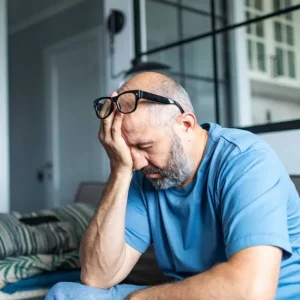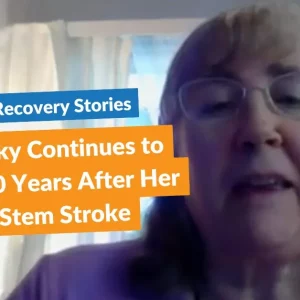Driving after stroke is a complex subject because a stroke affects every survivor differently. The severity of the stroke and the unique secondary effects that follow will determine whether or not survivors can safely resume driving.
Many people that sustain mild strokes are able to drive soon after stroke. However, those experiencing moderate to severe secondary effects, such as impaired mobility, vision, or cognition, may need rehabilitation to be able to drive again. It is essential for survivors and their families to work closely with their medical team and local driving agencies before returning to driving.
This article outlines the process of resuming driving after stroke. This includes a description of which factors to consider before driving and how to recover the ability to drive again. Understanding when it is appropriate to return to driving after stroke is essential for the safety of not only the survivor, but all others on the road.
Please use the links below to jump straight to any section of this article:
- When is it recommended to drive after stroke?
- Stroke effects that may impact driving
- Warning signs for unsafe driving
- Assessing driving skills
- Car adaptations for driving after stroke
- Rehabilitation techniques for driving again
When is it Appropriate to Resume Driving After Stroke?
A stroke occurs when the blood flow to the brain becomes compromised, damaging the associated neural tissues. Depending on the severity and location of damage, individuals may experience a wide range and intensity of secondary effects.
Therefore, determining when it is appropriate to resume driving after stroke is a highly individualized process. Guidelines regarding driving after stroke vary. Many countries recommending waiting at least 4 weeks after a mild stroke to resume driving. A few countries advise waiting at least 6 months before driving again to allow the brain adequate time to heal.
However, even if the allotted waiting period has passed, it is essential for survivors to be assessed and cleared by a medical professional before driving after stroke. Those who have sustained a massive stroke will likely experience more significant secondary effects, making it more challenging and time-consuming to regain the ability to drive safely.
Every stroke is different and each recovery process is unique. Thus, it is vital for survivors and their families to consult with the survivor’s medical team regarding when it is safe to resume driving after stroke.
Factors that May Impact Safe Driving after Stroke
Following the recommended waiting period, doctors will look for any lingering physical, visual, or cognitive problems that may impair one’s driving skills. There are five major factors that doctors will consider before allowing a survivor to drive after stroke.
1. Physical impairments
It is common for stroke survivors to experience motor changes after stroke. Physical effects of stroke that may impact driving include:
- Hemiplegia (one-sided paralysis)
- Spasticity (involuntary muscle tightness)
- Foot drop
- Muscle weakness
- Incoordination
- Pain
- Sensation changes
- Dizziness/vertigo
Fortunately, many of these challenges can be overcome with adaptive driving equipment and therapy. A solid exercise regimen may help survivors regain strength and mobility to return to driving safely.
2. Vision problems
About two-thirds of stroke survivors experience visual changes. Since healthy vision is necessary for driving, treating visual problems after stroke is imperative.
Some of the vision problems survivors may experience after stroke include:
- Blurred or double vision
- Problems with depth perception
- Loss of central vision
- Loss of peripheral vision
Vision therapy can often treat these issues. However, it is still critical to be cleared by a medical professional and a local driving agency (DMV) before returning to driving after stroke.
3. Cognitive effects
Driving a car not only requires physical strength and endurance, it also takes a significant amount of mental agility. Cognitive functions needed to drive safely after stroke include memory, concentration, problem-solving, multi-tasking, and way-finding skills. While a stroke can damage these skills, practicing cognitive training exercises can help survivors improve their cognition.
4. Fatigue
Post-stroke fatigue can result in unsafe driving, as it can cause difficulties with staying focused on the road or making quick judgments. In severe cases, post-stroke fatigue may even cause survivors to fall asleep at the wheel. Therefore, it is important for survivors struggling with post-stroke fatigue to learn to manage fatigue effectively before driving.
5. Epilepsy
Finally, about 5-10% of stroke survivors will experience a seizure after stroke. If a survivor has only one seizure after immediately after stroke, they will generally be cleared to drive, as long as no other significant impairments are noted.
However, some survivors experience multiple seizures after stroke, referred to as post-stroke epilepsy. These individualsoften have to be seizure-free for a period of time set by the DMV (typically several months) before driving again. Medical clearance is also essential for individuals who have experienced one or more post-stroke seizures.
Warning Signs that a Survivor is Unsafe to Drive After Stroke
Stroke often impairs a survivor’s self-awareness. This lack of insight may mean result in survivors being unable to recognize that they are unfit to drive.
Therefore, family members and caretakers should watch carefully for signs that an individual is not ready to drive after stroke. Some of these signs include:
- Needing instructions from a passenger
- Easily frustrated, confused, or distracted
- Drifting across lanes
- Slow reaction time
- Getting lost in their own neighborhood
- Driving faster or slower than the posted speed
- Making slow or poor decisions
- Difficulty managing the steering wheel or other controls within the car
With rehabilitation and appropriate adaptations, many survivors are able to resume driving weeks to months after displaying warning signs. However, if a survivor is currently presenting with any of these challenges, it is important to prevent them from driving until they can get their skills evaluated by a driving rehabilitation specialist.
Assessing Driving Skills After Stroke
When there is a question of whether a survivor is safe to be driving after stroke, doctors or therapists may administer clinical driving skill assessments. These are test that can be conducted in the office to assess a survivor’s driving abilities. These tests include:
- Road sign recognition test, which assesses visual comprehension and traffic knowledge.
- Compass task, which examines visual acuity, cognitive agility, and attention skills.
- Trail marking tests, that measures visual-motor tracking and visual scanning abilities. For example, one might be asked to draw a line across the page connecting various letters and numbers.
Depending on which state a survivor resides in, a doctor’s approval might be all that is required to resume driving after stroke. However, some states do require stroke survivors to also pass an on-road driving test to assess their ability to drive safely.
Car Adaptations for Driving After Stroke
Car adaptations allow individuals who are physically unable to drive to resume driving through modified controls and interior or exterior alterations. Some examples of car adaptations include:
- Spinner wheels, which attach to the steering wheel for one-handed steering
- Left-foot accelerators, for those with right side impairments
- Swivel seats, that help individuals get into and out of the car
Besides these tools, there are many other ways to adapt a vehicle so that is tailored specifically to the survivor’s needs and abilities. Talk to an occupational therapist for a full list of recommended car adaptations.
Rehabilitation Techniques for Driving Again
While adaptive equipment might help some stroke survivors get back on the road, it’s important to recognize that using car adaptations is a compensation strategy. This means it does not address the underlying deficits that caused the inability to drive safely. Therefore, rehabilitation should be pursued to prevent overreliance on adaptive techniques.
Fortunately, the brain possesses a remarkable ability to repair itself and recover lost functions through a process known as neuroplasticity. Neuroplasticity helps the brain rewire neural pathways, allowing undamaged portions of the brain to take over functions from damaged areas. This allows survivors to improve functions affected by stroke.
Neuroplasticity can be activated through consistent and repetitive therapeutic exercise. The more often a therapeutic task is performed, the stronger the associated neural pathways become.
While there are many therapies that can address the ability to drive, one of the most effective ways to regain the ability to drive after stroke is to work with a certified driver rehabilitation specialist. These individuals, who are often occupational therapists, will assess physical and cognitive functions related to driving in order to create a customized rehabilitation program tailored to the survivor’s needs.
Driving rehabilitation programs may involve recommending vehicle adaptations and practicing driving skills in a safe environment through driving simulations. Practicing functional skills during a driving simulation can help survivors learn which areas they need to continue to improve upon. Furthermore, examining simulated driving skills can allow healthcare professionals to more confidently recommend that a survivor is safe to resume driving after stroke.
Other therapies that can explicitly address the abilities needed to drive again after a stroke include:
- Vision therapy. Eye exercises can help restore visual clarity, perception, and scanning skills after a stroke. Working with a vision therapist is ideal, as they can identify unique vision problems and recommend targeted exercises.
- Cognitive exercises. Practicing certain cognitive exercises, such as memory games and puzzles, can engage neuroplasticity and improve the mental abilities needed in order to drive.
- Foot drop exercises. Foot drop can significantly impair driving skills. Fortunately, foot drop exercises can help survivors overcome this issue, which will allow individuals to use their gas and brake pedals effectively again.
Continuing to practice therapeutic exercises outside of therapy can help individuals rewire the brain more effectively to return to driving after stroke. While many therapists provide written home exercise programs, some survivors prefer to use programs such as FitMi or the CT Speech and Cognitive Therapy App.
These technology-based programs have the ability to adapt to a survivor’s specific skill level and are often more engaging that conventional home therapy. This motivates survivors to practice more frequently, which may allow them to return to driving after stroke even faster.
Ensuring Survivors Can Safely Drive After a Stroke
For many people, driving after stroke represents the ultimate goal of recovery. However, it is essential for survivors to ensure they are safe to resume driving in order to protect themselves and others on the road.
Therefore, it is important for survivors to work closely with their medical team to identify any barriers to safe driving and address them through therapeutic exercises and adaptations. With rehabilitation, many stroke survivors are able to safely resume driving after stroke.









